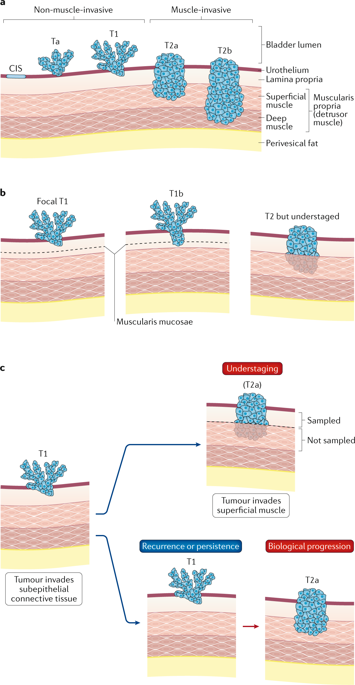Nature Reviews Urology ( IF 12.1 ) Pub Date : 2018-10-15 , DOI: 10.1038/s41585-018-0105-y Brian Jordan , Joshua J. Meeks

|
Stage T1 bladder cancers invade the lamina propria of the bladder and, despite sharing many of the genetic features of muscle-invasive bladder cancers, are classified as non-muscle-invasive or ‘superficial’ tumours. Yet, patients with T1 bladder cancer have an overall mortality of 33% and a cancer-specific mortality of 14% at three years after diagnosis, suggesting that these patients have a high risk of progression and, accordingly, require meticulous surgery, endoscopic surveillance and clinical decision-making. We hypothesize that the variability in the outcomes of patients with T1 bladder cancer is a result of both tumour heterogeneity and pathological staging, as well as inconsistencies in risk stratification, endoscopic resection and schedules of delivery of BCG. Owing to limitations in clinical staging, patients with T1 bladder cancer are at risk of both undertreatment with persistent use of BCG despite recurrence, and overtreatment with early cystectomy. Understanding the molecular features of T1 bladder cancers and how they respond to BCG therapy could improve biomarkers for risk stratification to align therapy with biological risk.
中文翻译:

T1膀胱癌:诊断和治疗的当前考虑因素
T1期膀胱癌侵犯了膀胱固有层,尽管具有肌肉浸润性膀胱癌的许多遗传特征,但仍被归类为非肌肉浸润性或“浅表性”肿瘤。然而,患有T1膀胱癌的患者在诊断后三年内的总死亡率为33%,癌症特异性死亡率为14%,这表明这些患者有较高的进展风险,因此需要进行细致的手术,内窥镜监测和临床决策。我们假设,T1膀胱癌患者预后的差异是肿瘤异质性和病理分期以及风险分层,内窥镜切除和卡介苗分娩时间表不一致的结果。由于临床分期的局限性,患有T1膀胱癌的患者既有复发的危险,仍然持续接受BCG的治疗不足,以及早期膀胱切除术过度治疗的风险。了解T1膀胱癌的分子特征以及它们对BCG治疗的反应方式,可以改善风险分层的生物标志物,使治疗与生物学风险保持一致。











































 京公网安备 11010802027423号
京公网安备 11010802027423号